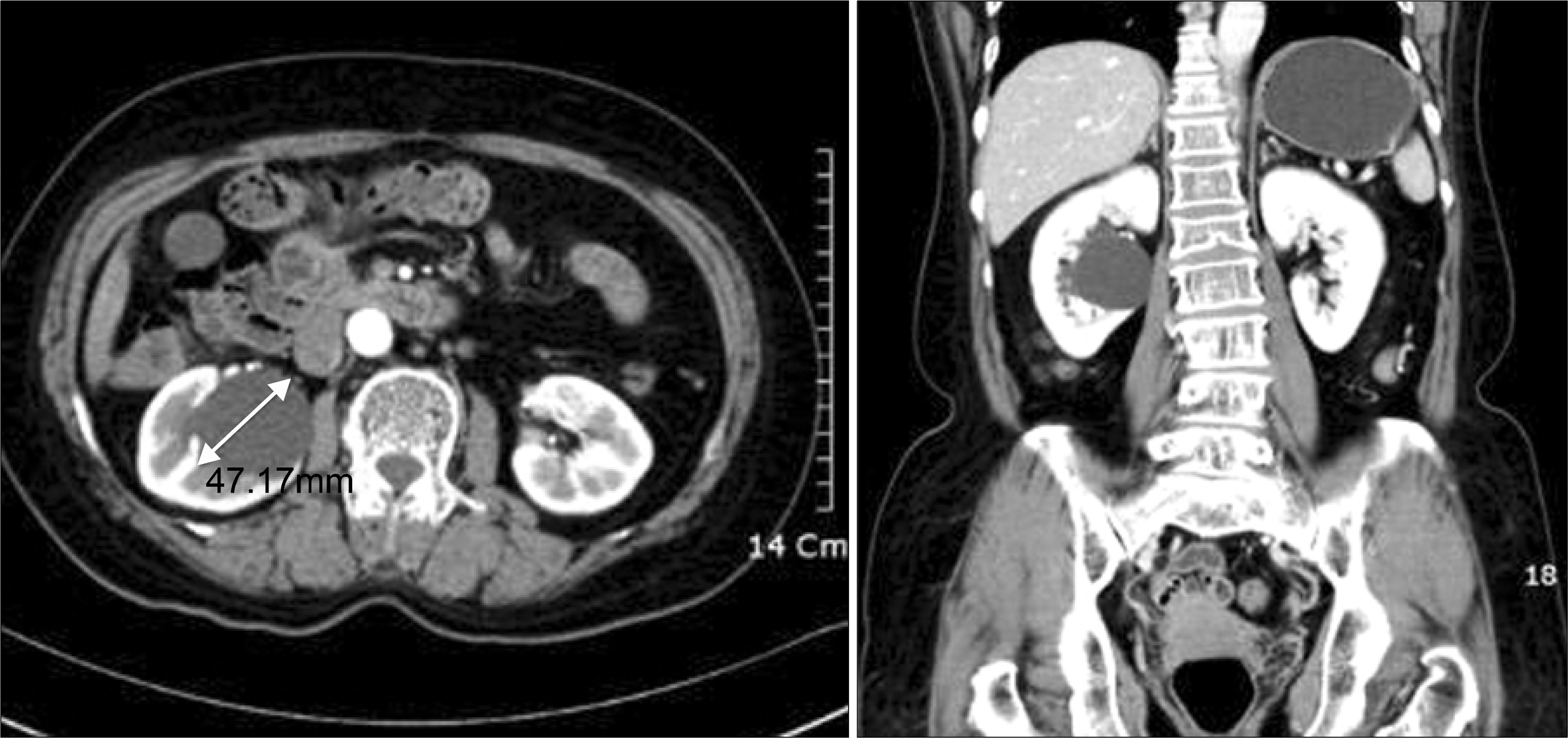Abstract
Purpose
The location of renal cysts is related with the symptoms and signs. Parapelvic cysts are a rare form of simple renal cysts, and they are much more commonly associated with the symptoms of obstruction, pain, infection and stone formation. We evaluated the surgical outcomes of laparoscopic renal cyst marsupialization for treating the peripheral and parapelvic types of renal cysts.
Materials and Methods
Between November 1993 and April 2007, 87 patients (91 cases) who presented with symptomatic renal cysts underwent laparoscopic renal cyst marsupialization. There were 76 cases in the peripheral cyst group and 15 cases in the parapelvic cyst group. The mean age was 59.2 years (age range: 20-77) for the patients with peripheral renal cysts and 62.9 years (age range: 47-79) for the patients with parapelvic cysts.
Results
The mean operative time was 108 minutes (30-280) for the patients with peripheral renal cysts and 144 minutes (80-270) for the patients with parapelvic cysts, and there was a significant difference (p=0.031). However for the other factors, including the time for the first oral intake, the time to remove the drain and the length of the hospital stay, there were no significant differences (p=0.671, 0.088, 0.268, respectively). Complications, including bleeding and leakage, were detected in 11 patients (14.4%) of the peripheral cyst group and in 4 patients (26.6%) of the parapelvic cyst group; there was a statistical difference (p=0.035). Both groups had a high success rate, 98.7% in the peripheral cyst group and 100% in the parapelvic cyst group.
Go to : 
REFERENCES
1. Kissane JM, Smith MG. Pathology of infancy and childhood. 2nd ed.St. Louis: CV Mosby;1975. p. 587.
2. Dean AL. Treatment of solitary cyst of kidney by aspiration. Trans Am Assoc Genitourin Surg. 1939; 32:91.
3. Hulbert JC, Shepard TG, Evans RM. Laparoscopic surgery for renal cystic disease. J Urol. 1992; 147:882.
4. Seo IY, Jeong CS, Jeong HJ, Rim JS. Long term follow-up results of laparoscopic renal cyst marsupialization: comparison with alcohol sclerotherapy. Korean J Urol. 2004; 45:360–4.
5. Oh CK, Kim DW, Lee KW, Lee YS, Yang SC, Rha KH. Cost analysis of renal cyst ablation: laparoscopic cyst marsupialization versus repeated sclerotherapy about recurrent renal cyst. Korean J Urol. 2006; 47:171–4.

6. Glassberg KI. Renal dysgenesis and cystic disease of the kidney. Walsh PC, Retik AB, Vaughan ED, Wein AJ, editors. editors.Campbell's urology. 8th ed.Philadelphia: Saunders;2002. p. 1964–74.
7. Amar AD, Das S. Surgical management of benign renal cysts causing obstruction of renal pelvis. Urology. 1984; 24:429–33.

8. Marumo K, Horiguchi Y, Nakagawa K, Oya M, Ohigashi T, Asakura H, et al. Incidence and growth pattern of simple cysts of the kidney in patients with asymptomatic microscopic hematuria. Int J Urol. 2003; 10:63–7.

9. Terada N, Ichioka K, Matsuta Y, Okubo K, Yoshimura K, Arai Y. The natural history of simple renal cysts. J Urol. 2002; 167:21–3.

10. Wolf JS Jr. Evaluation and management of solid and cystic renal masses. J Urol. 1998; 159:1120–33.

11. Camacho MF, Bondhus MJ, Carrion HM, Lockhart JL, Politano VA. Ureteropelvic junction obstruction resulting from percutaneous cyst puncture and intracystic isophendylate injection: an unusual complications. J Urol. 1980; 124:713–4.
12. Gauzzoni G, Montorsi F, Bergamaschi F, Consonni P, Bellin-zoni P, Centemero A, et al. Laparoscopic unroofing of simple renal cysts. Urology. 1994; 43:154–9.

13. Hoenig DM, Leveillee RJ, Amaral JF, Stein BS. Laparoscopic unroofing of symptomatic renal cysts: three distinct surgical approaches. J Endourol. 1995; 9:55–8.

14. Camargo AH, Cooperberg MR, Ershoff BD, Rubenstein JN, Meng MV, Stoller ML. Laparoscopic management of peripelvic renal cysts: University of California, San Francisco, experience and review of literature. Urology. 2005; 65:882–7.

15. Chun SJ, So YS, Kim CS. Retroperitoneal laparoscopic ablation of peripelvic renal cyst. Korean J Urol. 2002; 43:662–6.
Go to : 
 | Fig. 1.Abdominopelvic computed tomography shows a 4.7cm-sized right parapelvic cyst (arrow). It compresses the right renal pelvis and it may have caused the renal stones at the lower calyx. |
 | Fig. 2.Abdominopelvic computed tomography shows a 10.4cm-sized right peripheral cyst (arrow). |
Table 1.
The baseline characteristics of the patients in each groups
Table 2.
Comparison of the perioperative and follow-up data




 PDF
PDF ePub
ePub Citation
Citation Print
Print


 XML Download
XML Download